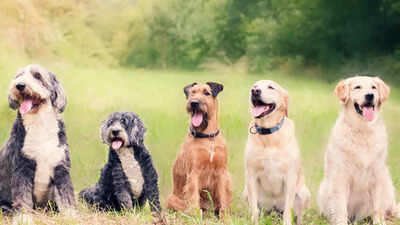Dogs were travelling the world with humans over 10,000 years ago, with surprisingly diverse forms |

Long before modern breeds like huskies, pugs or German shepherds existed, dogs were already journeying across continents with groups of humans. New research published in Science shows that dogs were not only living alongside people more than 10,000 years ago, but they were also far more varied in shape and size than we once imagined. These animals weren’t just companions — they were travellers, workers and cultural partners, sharing the adventures and struggles of early human societies.
Ancient skulls reveal early dogs were already surprisingly diverse
One team of researchers, led by Allowen Evin from the University of Montpellier, examined more than 600 skulls of ancient dogs and wolves, some dating as far back as 50,000 years. By comparing these skull shapes, they hoped to understand when dogs started looking like dogs rather than wolves.The results flipped old assumptions on their head.Scientists long believed that most of the physical diversity we see today — from long-nosed sighthounds to flat-faced bulldogs — came from very recent selective breeding over the last few hundred years. But these new findings show that early dogs living 11,000 years ago already had a surprising variety in their skull shapes.Some had long, wolf-like faces. Others had shorter snouts or rounder heads. And many were somewhere in between. This early variety suggests dogs were adapting to different environments and different roles around humans — long before modern breeding existed.Even the oldest skulls from the Ice Age, which some researchers once thought belonged to early dogs, turned out to look more like wolves when analysed with modern tools. This means physical changes were gradual and took thousands of years, not sudden or simple.In other words, dogs were not created overnight. They slowly morphed from wolves into helpful human companions through a long, complex process influenced by climate, culture and survival needs.
DNA shows dogs travelled long distances with humans
The second study, led by Shao-Jie Zhang of the Kunming Institute of Zoology, analysed the DNA of 73 ancient dogs across Eastern Eurasia. This genetic detective work uncovered a fascinating pattern: dogs moved with people as different human groups travelled, migrated or traded across vast distances.Hunter-gatherers carried dogs with them as they explored new territories. Early farmers took their dogs along when they spread east and west, bringing new crops and tools. Nomadic herders also travelled with dogs that helped guard livestock and campsites.What surprised scientists most was that sometimes the dogs didn’t match the humans genetically. For example:Ancient people in one region might have Western ancestry, but their dogs had Eastern ancestry.This suggests the dogs were exchanged, traded or gifted between communities.It paints a picture of ancient dogs not just as tag-along pets, but as valuable partners in daily life — perhaps even prized possessions worth sharing or trading between groups.Dogs likely helped humans hunt, protected camps from predators, provided warmth, and even acted as early “alarm systems.” In return, humans offered food, safety and companionship.This two-way relationship is one of the oldest and most enduring animal–human partnerships on Earth.
What this means for our understanding of early dogs
Taken together, these two studies reshape our understanding of how dogs evolved and how they became such an important part of human life.Here is what the new science tells us:
- Dogs were already diversifying thousands of years before modern breeds.
- They were travelling with humans across enormous distances, from Europe to eastern Asia.
- They played roles in hunting, guarding and survival.
- They were exchanged and shared between communities, showing their value.
- Their skulls and DNA capture forgotten stories of ancient human movement.
This research shows that ancient dogs were not just “tamed wolves.” They were lively, adaptable, and essential members of early societies.Their bodies evolved as they lived in harsh cold climates, dense forests, grasslands and growing villages. Their genes changed as they followed new human groups or joined different communities. And their diversity blossomed as they took on new roles — hunting partners, protectors, companions and travellers.
A bond shaped by thousands of years of shared journeys
What makes these findings truly special is what they say about the human–dog relationship.It wasn’t a brief moment in history. It was not just about feeding scraps to wolves who hung around early camps. Instead, humans and dogs spent thousands of years moving, surviving, adapting and exploring together.Dogs were:
- early travellers
- early workers
- early trading goods
- early helpers
- and early friends
Their bones and DNA act like time capsules, showing where our ancestors went, who they met, and how they lived.The long partnership between humans and dogs helped shape both species. And the diversity of today’s dogs — from tiny Chihuahuas to huge Great Danes — began long before modern breeding, rooted in those ancient travels and shared lives.






